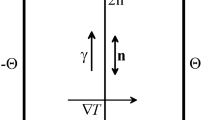Abstract
The effect of normal vibrations of a flat horizontal heater on the second boiling crisis is considered within the framework of the hydrodynamic theory of boiling crises. The critical heat flux is estimated by characteristics of growth of the most dangerous disturbances destroying the liquid-vapor interface. As the vibration intensity increases, the interface can be destroyed either owing to the Rayleigh-Taylor instability or by virtue of parametrically excited disturbances with wavelengths corresponding to resonance zones. In the domain of parameters where the parametric instability in the first resonance zone is the most dangerous factor, it is possible to significantly reduce the critical heat flux, as compared with the value corresponding to the case with no vibrations. With a further increase in vibration intensity, the critical heat flux increases as a whole. The nonmonotonic character of the critical heat flux as a function of vibration intensity allows an effective control of the critical heat flux whose value can be made higher or lower than the value in the case without vibrations.
Similar content being viewed by others
References
V. I. Sorokin, “Effect of spouting of drops from the surface of a vertically oscillating liquid,” Akust. Zh., 3, 281–295 (1957).
T. B. Benjamin and F. Ursell, “The stability of the plane free surface of a liquid in vertical periodic motion,” Proc. Roy. Soc. London, Ser. A, 225, 505–515 (1954).
V. A. Briskman, “Parametric stabilization of the interface between liquids,” Dokl. Akad. Nauk SSSR, 226, No. 5, 1041–1044 (1976).
N. A. Bezdenezhnykh, V. A. Briskman, G. V. Puzanov, et al., “Effect of high-frequency vibrations on stability of the interface between liquids,” in: Hydrodynamics and Mass Transfer in Microgravity [in Russian], Nauka, Moscow (1982), pp. 34–39.
A. A. Cherepanov, “Effect of variable external fields on the Rayleigh Taylor instability,” Preprint No. 29-53, Inst. Cont. Media Mech., Sverdlovsk (1984).
N. Zuber, “Hydrodynamic aspect of boiling heat transfer,” Report No. AECU-4439, Atom. Energy Commission, Los Angeles (1959).
J. H. Lienhard and P. T. Y. Wong, “The dominant unstable wavelength and minimum heat flux during film boiling on a horizontal cylinder,” Trans. ASME, J. Heat Transfer, 86C, No. 2, 220–226 (1964).
J. H. Lienhard and L. C. Witte, “A historical review of the hydrodynamic theory of boiling,” Rev. Chem. Eng., 3, No. 3, 187–280 (1985).
E. T. Whittaker and G. N. Watson, A Course of Modern Analysis, Cambridge University Press (1927).
A. Nayfeh, Introduction to Perturbations Techniques, Wiley, New York (1981).
Author information
Authors and Affiliations
Additional information
__________
Translated from Prikladnaya Mekhanika i Tekhnicheskaya Fizika, Vol. 47, No. 4, pp. 88–97, July–August, 2006.
Rights and permissions
About this article
Cite this article
Konovalov, V.V., Lyubimova, T.P. & Lyubimov, D.V. Effect of normal vibrations of a flat horizontal heater on the second boiling crisis. J Appl Mech Tech Phys 47, 534–541 (2006). https://doi.org/10.1007/s10808-006-0086-0
Received:
Revised:
Issue Date:
DOI: https://doi.org/10.1007/s10808-006-0086-0




